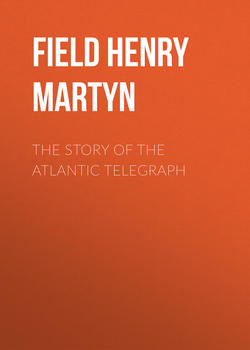The Story of the Atlantic Telegraph

Реклама. ООО «ЛитРес», ИНН: 7719571260.
Оглавление
Field Henry Martyn. The Story of the Atlantic Telegraph
PREFACE
CHAPTER I. THE BARRIER OF THE SEA
CHAPTER II. CAN THE OCEAN BE SPANNED?
CHAPTER III. THE COMPANY ORGANIZED
CHAPTER IV. CROSSING NEWFOUNDLAND
CHAPTER V. THE DEEP-SEA SOUNDINGS
CHAPTER VI. THE WORK BEGUN IN ENGLAND
CHAPTER VII. SEEKING AID FROM CONGRESS
CHAPTER VIII. THE EXPEDITION OF 1857
CHAPTER IX. THE FIRST EXPEDITION OF 1858
CHAPTER X. THE SECOND EXPEDITION SUCCESSFUL
CHAPTER XI. EXCITEMENT IN AMERICA
CHAPTER XII. DID THE FIRST CABLE EVER WORK?
CHAPTER XIII. CAST DOWN, BUT NOT IN DESPAIR
CHAPTER XIV. THE EXPEDITION OF 1865
CHAPTER XV. PREPARING TO RENEW THE BATTLE
CHAPTER XVI. VICTORY AT LAST
CHAPTER XVII. RECOVERY OF THE LOST CABLE
CHAPTER XVIII. THE AFTERGLOW
APPENDIX. INSTRUMENTS FOR SIGNALLING ACROSS THE ATLANTIC OCEAN
Отрывок из книги
When Columbus sailed from the shores of Spain, it was not in search of a New World, but only to find a nearer path to the East. He sought a western passage to India. He had adopted a traditionary belief that the earth was round; but he did not once dream of another continent than the three which had been the ancient abodes of the human race – Europe, Asia, and Africa. All the rest was the great deep. The Florentine sage Toscanelli, from his knowledge of the world so far as then discovered, had made a chart, on which the eastern coast of Asia was represented as lying opposite to the western coast of both Europe and Africa. Accepting this theory, Columbus reasoned that he could sail direct from Spain to India. No intervening continent existed even in his imagination. Even after he had crossed the Atlantic, and descried the green woods of San Salvador rising out of the western seas, he thought he saw before him one of the islands of the Asiatic coast. Cuba he believed was a part of the mainland of India; Hayti was the Ophir of King Solomon; and when, on a later voyage, he came to the broad mouth of the Orinoco, and saw it pouring its mighty flood into the Atlantic, he rejoiced that he had found the great river Gihon, which had its rise in the garden of Eden! Even to the hour of his death, he remained ignorant of the real extent of his magnificent discovery. It was reserved to later times to lift the curtain fully from the world of waters; to reveal the true magnitude of the globe; and to unite the distant hemispheres by ties such as the great discoverer never knew.
It is hard to imagine the darkness and the terror which then hung over the face of the deep. The ocean to the west was a Mare Tenebrosum – a Sea of Darkness, into which only the boldest voyagers dared to venture. Columbus was the most successful navigator of his time. He had made voyages to the Western Islands, to Madeira and the Canaries, to Iceland on the north, and to the Portuguese settlements in Africa. But when he came to cross the sea, he had to grope his way almost blindly. But a few rays of knowledge glimmered, like stars, on the pathless waters. When he sailed on his voyage of discovery, he directed his course, first to the Canaries, which was a sort of outstation for the navigators of those times, as the last place at which they could take in supplies; and beyond which they were venturing into unknown seas. Here he turned to the west, though inclining southward toward the tropics (for even the great discoverers of that day, in their search for new realms to conquer, were not above the consideration of riches as well as honor, and somehow associated gems and gold with torrid climes), and bore away for India!
.....
This is a testimony most honorable to the engineer who first led the way through a pathless wilderness. But this Newfoundland scheme is not to be confounded with that of the Atlantic Telegraph, which did not come into existence until a year or two later. The latter was not at all included in the former. Indeed, Mr. Gisborne himself says, in a letter referring to his original project: "My plans were to run a subterranean line from Cape Race to Cape Ray, fly carrier-pigeons and run boats across the Straits of Northumberland to Cape Breton, and thence by overland lines convey the news to New York." He adds however: "Meanwhile Mr. Brett's experimental cable between Dover and Calais having proved successful, I set forth in my report, [which appeared a year after his first proposal], that 'carrier-pigeons and boats would be required only until such time as the experiments then making in England with submarine cables should warrant a similar attempt between Cape Ray and Cape Breton.'" But nowhere in his report does he allude to the possibility of ever spanning the mighty gulf of the Atlantic.
But several years after, when the temporary success of the Atlantic Telegraph gave a name to everybody connected with it, he or his friends seemed not unwilling to have it supposed that this was embraced in the original scheme. When asked why he did not publish his large design to the world, he answered: "Because I was looked upon as a wild visionary by my friends, and pronounced a fool by my relatives for resigning a lucrative government appointment in favor of such a laborious speculation as the Newfoundland connection. Now had I coupled it at that time with an Atlantic line, all confidence in the prior undertaking would have been destroyed, and my object defeated." This may have been a reason for not announcing such a project to the public, but not for withholding it from his friends. A man can hardly lay claim to that which he holds in such absolute reserve.
.....